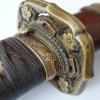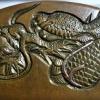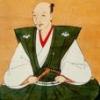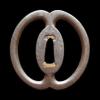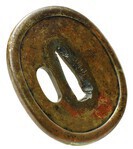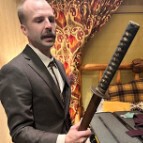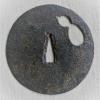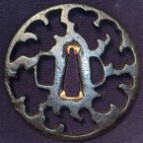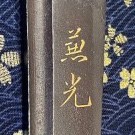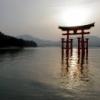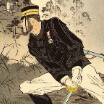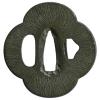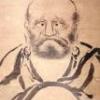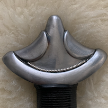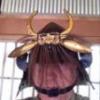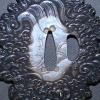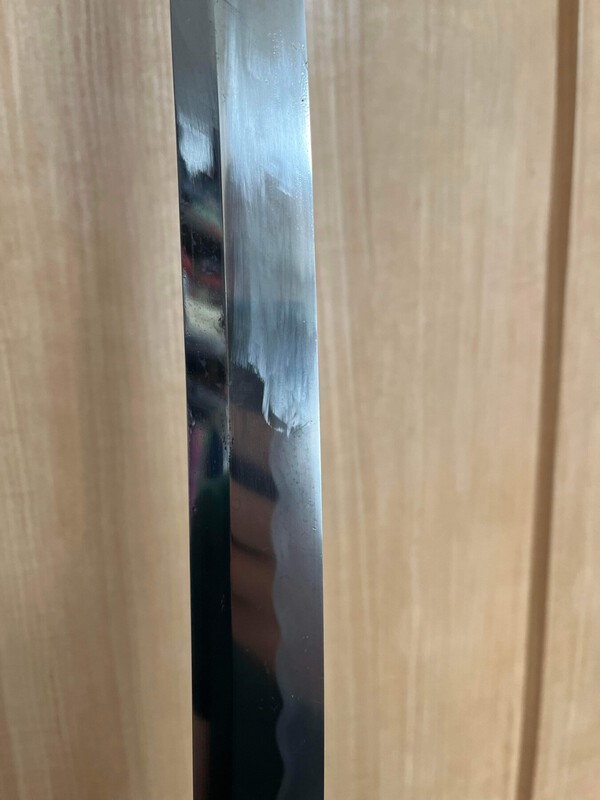Leaderboard
Popular Content
Showing content with the highest reputation on 12/09/2024 in all areas
-
Yesterday, I was at a militaria show. I had an appointment with a dealer to look at a Gunto sword he had for sale. The seller also had this beautiful kogai. I found it very attractive so I made the deal and bought both. Although the kogai is not signed the craftsmanship is above average. To share my excitement just a few pictures. Feel free to comment. Regards, Ed10 points
-
Hey Glen Okay, while I generally am in very close agreement with your sentiments in these threads, as you know, I do need to draw attention to the quoted selection above, for two reasons. First, there are period documents from the late-Momoyama that record the move of the Shodai and Nidai Yamakichibei, specifically, from Kiyosu to Nagoya in the course of the Kiyosu-goshi -- the transfer of the political seat of Owari province from Kiyosu to Nagoya between 1610 and 1613 (See page 70 of Markus Sesko's translation of Okamoto Yasukazu's Owari To Mikawa no Tanko). These are labeled as "transmissions handed down over time" (not sure by whom and to whom), and which now reside in the Tokugawa Museum in Nagoya (where it is rather unlikely they would be if they were much later documents, say, late-19th-century or later). Moreover, it is known that the O-Shodai Yamakichibei's full name was Yamasaka Kichibei Shigenori, and, importantly, the kanji of "Shigenori" are known ("Shigenori" can be written using various kanji). For the specific kanji of his name to be known -- when he never signed with "Shigenori" on any of his known tsuba, it would seem necessary that there were documents with his name recorded, and it would seem likely that these would be documents contemporary to his life. Further, Yamasaka Kichibei Shigenori was also known as Shizuyama Yoshii, again, with the kanji known. How would this additional name -- which likewise has never appeared as a mei on his sword guards -- and the kanji used to write it, be known if there were not period documents to record it, especially since this was never a name he used to sign his work? Additionally, he is known to have been active in Genki (1570-1573) -- a relatively brief and obscure period to note his active years (in part) if someone were just conjuring a fiction about him well after the fact -- and to have lived in Kiyosu near Oda Nobunaga's Kiyosu castle. He was known there early on as an armor maker, working for the Oda. I think it is good to remember that we may not (or certainly do not) have access to all of the records that may exist or have existed about these early smiths (who knows how many have been lost to fires, floods, etc...?). Sometimes, the mention of these smiths may have occurred in an otherwise pedestrian document, as in the case of the recording of the Shodai and Nidai Yamakichibei moving from Kiyosu to Nagoya (it's possible that they were only two of a number of artisans whose move was recorded for census, or some such prosaic reason). I have looked for, but cannot find in my library at the moment, a publication that mentions it having been recorded that Yamasaka Kichibei Shigenori was sent out into the field by Oda Nobunaga to repair armor. I cannot speak to the veracity of this account, of course, but I have seen several such documents that record quite ordinary orders of various Daimyo, high-ranking bushi, etc regarding very unremarkable tasks. Perhaps this document exists somewhere, but it has never been translated into English or published in many or any books because it does not directly involve "tsuba knowledge." In any event, I have little doubt (actually, no doubt, really) that the early Yamakichibei smiths were certainly Kiyosu men, and then, in the case of the Meijin-Shodai and Nidai, later moved on to Nagoya. In other words, definitely Owari. The second reason I wanted to call attention to the quote above concerns certain logical likelihoods which, in the absence of certainties and objective proof, stand in as "the best available thinking" on a question or issue. Here, I am speaking of the place and time origins of Kanayama guards. You quote Sasano in his thoughts regarding the similarity in construction between Yamakichibei tsuba and those now called Kanayama, and his drawing the conclusion that it would then seem likely that Kanayama tsuba would also have been made in Owari. Two things need to be emphasized here: 1. The similarity in construction between Yamakichibei sword guards and Kanayama sword guards is not merely high, it is so close that no other tsuba-making tradition comes anywhere near these two in terms of the highly specific shared aesthetic sensibilities they express and the peculiar and shared combination of construction methods they employ. 2. While Kanayama tsuba closely resemble Yamakichibei tsuba and vice-versa, nothing else comes remotely close to either one, even so-called Owari sukashi tsuba, Nobuiye tsuba, or Hoan tsuba. No other tsuba made anywhere else in Japan before, during, or after the Momoyama Period looks remotely like a Yamakichibei work, except a Kanayama work, and vice-versa, in terms of specific Tea Culture aesthetics and then also of construction. It is those two groups...and that's it. So, when Sasano posits that Kanayama guards -- in resembling the construction methods (and aesthetics) of Yamakichibei guards -- were therefore likely also made in Owari, it is a damn good guess, especially in the absence of any other viable. evidence-based theory. I mean, where else would they have been made? Kyoto? Well, mayyybe. But if so, they would have really stood out for their "crudeness" in a capital city known for its pride in the elegance and grace of its ways and wares. Do Kanayama guards look like Kyoto's Umetada guards? Or Kaneie guards? Or Shoami guards? Do they look "Kyoto" at all? And if not Owari or Kyoto, where? So, while I absolutely take your point that there is a huge Emperor's New Clothes situation in the world of tsuba scholarship and nomenclature, I think there is some room for a bit of middle ground between knowing 100% that something is the case, on the one hand, and then saying that we know nothing at all, on the other (*We can save epistemological discussions on the nature of knowledge for another time... ). Circumstantial evidence is admissible in Court (in many cases) for a reason. There are, of course, varying degrees of circumstantial evidence, but if one employs sound inductive analytical methods and then qualifies one's conclusions and statements appropriately after the analysis, there is, as I say, some room for this I think, especially given how likely it is that we really can never know for sure many things about pre-Edo tosogu. I recognize that the primary driving force behind your opening this thread is that the above methods are not used and have not been used historically in tsuba scholarship, as your posts have so well pointed out, and that this has led to all kinds of fictions in what passes for knowledge on the subject. The motives behind this are due variously to laziness, to deference (iemoto-ism), and then at timesperhaps to more unsettling (unscrupulous) reasons. In any event, I think it is quite clear that the significant majority of what we read about "schools" and labeling, particularly of anything pre-Edo, is untenable. And while we may not actively be able to really do much about the "traditions" in place, simply knowing how thin are the foundations on which they're built can aid many of us in our efforts to attempt to pierce through the flimsiness.5 points
-
Welcome to the NMB aka the AWJMB "Arguing With Jacques Message Board", as you'll see, his attitude often attract controversies. But please, no need to offend innocents ones, Jacques behaviour only commits himself. And is not a norm here in France. Many Frenches here will be pleased to help you if they can. Best regards. Benjamin3 points
-
3 points
-
These are "Hazama" tsuba using the exotic sahari inlay (silver, lead, tin, etc mix- possibly using mercury in the process) that is incredibly hard and possibly toxic in the manufacturing process. Ford said he could do it, but I would say it is one of the times where his bravado got ahead of him. His sahari inlay did not convince me at all. It looked very modern to my eyes. Sahari was also used to inlay gun barrels, as it won't suffer from the heat. Sometimes Hazama (and closely related Kunitomo) tsuba are referred to or known as "gun-maker" tsuba and enjoy a little panache in Japan for that reason. The orange lighting from above doesn't help. Having seen at least 100 of these and owned 4 or 5, I can look past the odd lighting and properly imagine what they look like. For Hazama, the designs are on the dramatic side. I'm not saying I'd want to own either, but the inlay and use of sahari on the Taiko drum Hazama is relatively impressive. I doubt the ropes are sahari. They are probably another much softer metal, like silver. Very unique tsuba, but I'd 100x more prefer to have the skull Nobuiye.3 points
-
1, 鉄地丸形真鍮象嵌土手耳小柄櫃穴 2. 丸に三引両紋草花図鐔 3. 無銘 応仁 4. 室町時代ノ応仁年間(一四六七~一四六八)頃ニ製 5. 作サレタト伝ワル薄手土手耳ノザングリシタ 6. 地鉄ニ点象嵌縄目切込ノ真鍮象嵌ニ 7. ヨル簡素ナ文様就中櫃穴ヤ切羽台ヲ真 8. 鍮象嵌デ囲ム技法ハ応仁鐔ノ特色也 9. 平成十九年十二月誌[kao?] 10. 付 コノ鐔ノ小柄櫃穴ハ最初ハ無ク後世ニ開ケラレタモ 11. ノデアル表裏ノ穴マワリノ真鍮象嵌文様ガ切断サレ 12. テイルコトニ依リ明白也 13. 保存刀装具鑑定書付(平成九年六月二十日)3 points
-
Heres one befitting an Ichimonji blade... Tachi Koshirae: Shichiyo-mon (NBTHK Tokubetsu Hozon Tosogu) - Japanese Sword Shop Aoi-Art2 points
-
What you say to others concerns not only you, but also the people you say those words to. Otherwise, why say anything at all? A little empathy can go a long way. -Sam2 points
-
I would also caution against drawing hard conclusions based on machine translations of the texts above. Japanese language contains a lot of subtleties and ambiguities which can go missing, or can get translated into non-negotiable English terms, when translated by google or AI. Plus, the translations often stumble over kanji, which themselves contain information that may get lost in translation.2 points
-
What is the subject? A suspended bottle of some sort? Shinto related? Never seen it before.2 points
-
I am not sure, but it could be 三原住政宗 (or 家?) – Mihara ju Masamune (or Masaie?).2 points
-
This got me motivated to go through my archive and set aside items where the dating is not secured, though has been theorized and leave only the items for which it has been established. Good thing about continental finds they often come with a sword, which in turn is dataable... so far to my surprise I see solid plates as early continental tsubas, though on the other hand wheel is not such a big symbol on the continent. But still, the flood of sukashi appears to coincide with late Muromachi...2 points
-
Tom, "adding" a DOTE MIMI is probably less work than cutting it out from a thick plate! It is standard work for a good TSUBAKO, and in your case, it looks quite well made.2 points
-
Points of note: "THERE ARE NO MENTIONS OF KYOTO (what we would call Kyo-sukashi or Heianjo sukashi, I assume), SHOAMI, OR OWARI IN ANY EDO PERIOD DOCUMENTS" and there are varying contradictory accounts of what a "KANAYAMA" might be... "The Toban Zufu... ~(1716-1736) states "there is a place called Kana Yamate, where the watermark is immediately and greatly expanded, and it is a place of divination" I presume this could/should be read as: "sukashi tsuba suddenly appeared and proliferated in a sacred area called Kana Yamate". "in Kinjo Sokuyose" by Tanaka Kazushige (1839), "the NAMES AND PLACES "Kanayama" and "Yamada" are UNKNOWN". from Sasano himself: "However, since the construction of the steel frames and the first and second generations of Yamasaka Kichibei is quite similar, IT IS BELIEVED that the two are related and that KANAYAMA WAS BUILT IN THE OWARI REGION". well dayum... that's pretty damn close to the original statement that I posted as second hand information from a discussion (great memory BK!!! ). So we actually have NO IDEA WHERE these were produced, we're just working off of assumptions... and solely because Kanayama and Yamakichibei seem to have similar "iron bones" along their edges... AND that's only going off the assumption that the first and second gen of Yamakichibei were made in Owari to begin with (no offical record of this exists... just some other assumptions and quotes like "it is said that...blah blah blah") I mean WTF? Really? THIS IS WHAT OUR SUKAHSI TSUBA "SCHOOLS" SYSTEM IS BASED OFF OF???? We simply HAVE TO DO BETTER THAN THIS, or at the very least acknowledge how flawed it is and start constructing a better framework. Clearly the names themselves are pretty much meaningless and arbitrary. Unfortunately institutions like the NBTHK are still following these narrow sets of school names (all tracing back one way or another to the influence of Akiyama in the early 1900s through his regular meetings of his sword study group) and have been continually ramming in other unknown, unsigned, undocumented tsuba styles into these already existing constructs because they simply don't know what else to call them. They even go along with all the "Ko" b.s. like "ko-shoami" and "ko-umetada" (meaning older than / predecessors)... the tsuba certainly exist, but attaching them to other existing school names is just ridiculousness piled on top of ridiculousness. By the way, the first time we actual signed SHOAMI tsuba is in the mid to late 1600s (early Edo period) and they look NOTHING like any of the so called "ko-shoami" group of tsuba. TEHRE IS ABOSLUTELY NO RECORD OF ANY SHOAMI PERSON MAKING TSUBA BEFORE THAT!!! The only record of a pre-Edo "Sho-Ami" (spelled using different kanji) was only documented as being a "silversmith" for the Ashikaga. Just the one record, that's it, and that's all... and NO MENTION OF ANY TSUBA PRODUCTION WHATSOEVER. Pure fantasy... So there are plenty of really nice "ko-shoami" tsuba out there, but the name is complete garbage and has nothing to do with any kind of lineage. In my opinion, these should be grouped and categorized and given new names based on their "type"... or something along those lines.2 points
-
2 points
-
Older blades, who lost their signature and were shortened later to be carried as katana, should be displayed as katana, i.e. with the cutting edge up. No mattter what their original shape and purpose were. reinhard2 points
-
The date is unclear, but may be Enpo 7 (a lucky day in the eight month of 1679).2 points
-
Hi Bradley, As stated by others, doesn't make a lot of difference which style/pieces you choose because when you're done the koshirae will be modern and put together by a westerner. Nothing wrong with your plans but keep in mind that, when you're finished with the build, if you spent $5,000 on it you will have no trouble getting $2,000 back when the time comes to sell. Collectors want original, antique koshirae. I think it makes better sense to look for an existing antique koshirae mounted with tsunagi that you can display next to the tachi in its shirasaya, which is where it belongs. If you choose well you'll have no trouble getting your money back. Grey2 points
-
Must be strange for someone coming to a forum just looking for help and end up there being a debate about whats ok or not to collect.2 points
-
It's all down to personal taste. For me, a Tensho koshirae in the style seen in the Uesugi collection (including the Sanchomo koshirae).2 points
-
Here is an example of an itomaki-no-tachi koshirae which was formerly a possession of the Mōri clan.1 point
-
1 point
-
1 point
-
Gentlemen, Christmas is coming, we should all be more kind :). I have read many posts of Jacques and first of all I thank him as many others on the forum for his contribution, it is always taken for granted to have an answer for me it is not so ... my work generally leads me to always grasp the positive aspects of the various characters, I agree that sometimes his answers go beyond the limit (Often without reason) and can be considered offensive especially for newcomers but for me his vision that may seem narrow and elitist and his obstinacy in always looking for a counter-proof is still praiseworthy and useful also to deepen the issues, everyone here expresses his point of view and knowing the way of thinking of a person also helps to contextualize his opinion and to relate it to your own according to different criteria, also I personally don't judge anyone in relation to the blades they keep... if you only buy Juyo it means you have money to buy them, not that you are an expert. Even in this post his answer is rude but ultimately not wrong, this is not a piece that should be bought... but personally I think that we should always think of people who want to keep an antique / original piece for display useful for conversation without other intentions. From this point of view the price paid (Seen on another site) is lower than the cost of the tamahagane needed to make the blade... not the deal of the century but it's not a tragedy either... personally I prefer that these pieces are lived rather than rusting in some cellar. @Benjamin Just for fun my last interaction with a potential French customer: Me: Hello Sir can I help you? Customer: Oui Me: Excuse me Sir do you speak English? Customer: yes but I don’t want to speak English Me: Giordy1 point
-
Usually very heavily gilded but gold ones were made at obviously a very high cost. Difficult to tell which it is sometimes. Have never seen an inro resembling this. Looks more like something for an important presentation. Sacre sake or similar? Puzzled.1 point
-
Stylised Inro or incense burner? That what struck me. Whatever it is the piece shows superb workmanship. Are these pieces usually solid gold or gilded?1 point
-
And being Jacques, if it was useless for him he will make sure its useless for everyone, as he does.1 point
-
1 point
-
The great Kanehira may be a stretch, but it does appear to be an old Bizen blade.1 point
-
1 point
-
Trouble with some information on page 5 of the PDF - Modern studies on “Tsuba” started only from the beginning of the 20th Century In Japan 『刀剣会誌』(刀剣会): 1900 onward 秋山久作 (日本鐔研究界の始祖) 和田維四郎『本邦装剣金工略誌』(1913) In Europe Hara, Shinkichi, Die Meister der Japanischen Schwertzieraten (1902) G. Jacoby, Japanische Schwertzieraten (1904) A. G. Moslé, Japanische Kunstwerke (1909) "Modern studies on “Tsuba” started only from the beginning of the 20th Century" Clearly this is untrue. THE 'ORNAMENTAL ARTS OF Japan' VOLUME II by: GEORGE ASHDOWN AUDSLEY (1884) THE ART AMATEUR : TALKS WITH EXPERTS. no. 2 Heromich Shugio : On Japanese Sword-Guards. Dated 1888 "The Scottish Arts Review" Vol.I Japanese SWORD-GUARDS. By J. P. MacGillivray. 1888-1889 The Portfolio; "SOME Japanese SWORD-GUARDS". by Philip Gilbert Hamerton. published 1889 Japan and its ART by Marcus B. Huish, L.L.B. 1889 Japanese ART by Louis Gonse translated from French by M. P. Nickerson. (1891) CATALOGUE of the COLLECTION Japanese SWORD-GUARDS Louvre Museum, gift of Mr. Tadamasa Hayashi of TOKIO 1894 HISTORY OF ART IN Japan Commission impériale à l'Exposition universelle de Paris, Dated 19001 point
-
So it WAS AKIYAMA who ASSUMED that "Owari" tsuba were made there because of the location inscribed in the signature of the third "Sakura" Yamakichibei, who WAS KNOWN TO BE WORKING DURING THE EARLY EDO PERIOD!!!! So he just assumed that the pre-Edo sukashi tsuba were also made there. So again, everything we THINK WE "KNOW" about these pre-Edo period sukashi tsuba schools are just BUILT ON ASSUMPTIONS, and then ASSUMPTIONS BUILT OFF OF THE PREVIOUS ASSUMPTIONS.... it's all just early 20th Century theorizing that has never been verified by any period documents of any kind... or verifiable EVIDENCE OF ANY KIND for that matter...1 point
-
1 point
-
Here is a photo of a tsuba that looks to have had religious (Christian) imagery added to the tsuba at some point well after being made. I’m assuming that the imagery was not original to the tsuba because of the placement of the images immediately around the nakago-ana, which would have resulted in the images being partially covered, though not fully, so as to intentionally obstruct the nature of the imagery. I’ve also not seen other Edo era Christian imagery made in this style. In any case, adding this here as a potentially-good case study of tsuba that had religious imagery added well post production.1 point
-
Thank you. It is the first time that I have seen those in color.1 point
-
This is clearly not the case given that there are maybe 1000 listings per day on YahooJ... granted a fair number of those are re-posts, but still...1 point
-
Looks like: 永延元十月 __ (Unsure on this) 備前國包平 (Bizen Kuni Kanehira)1 point
-
Gendaito Project YOSHIHIRO (慶広・慶廣), Saitō MOTOHIKO (元彦), Saitō KIYOMARU (清丸), Saitō KAZUFUSA (和房), Saitō MASANAKA (正中), Saitō1 point
-
1 point
-
I would say copper not brass. But overall very unconvincing from what I can see.1 point
-
I think the biggest problem we are going to encounter is the lack of reliably dateable complete Koshirae in between Nanbokucho and the Late Muromachi period, it is a bit of black hole, a sign of the turbulent times I guess. For the investigation to continue, I think it will be important to source Koshirae examples from this period, even if they do not include Sukashi Tsuba, so that we can form a base line of what was in use.1 point
-
So very much like the Rai hada you find so appealing? 🤣 Jacques, it really wouldn’t hurt you to offer something constructive. Many other board members take their study seriously but manage to do so without your attitude. If you can’t say anything good, say nothing.1 point
-
It's an interesting theory Kirill @Rivkin I can see a few issues with the theory, and this tsuba example in particular. First, the theory that there was a continuous production of sukashi tsuba dating all the way back to the Kofun period. (300 to 538 CE). These Guruma (wagon wheel) type sukashi were stylistically a dominant form during the Momoyama period after the long period of use of the so-called Katchushi and Tosho that have flat thin plates (WITHOUT any form of Guruma sukashi). So if they were in production since the Kofun period, as your theory proposes, it begs the question why this style was "lost" at some point and then suddenly "revived" again en masse, in bulk quantities in the Momoyama period. From the existing multitude of both published and available tsuba, it's clear that the Guruma form was "new" and "popular/in demand" and being "played around with" during the Momoyama. So, if the theory of continuous production of Guruma type sukashi was correct, then we would expected tens of thousands of examples of these type of tsuba, given an additional 1000 years of production between the Kofun and the Momoyama... so we certainly wouldn't only have literally just a handful of examples. With the current number of examples of the type you are showing, we would have to presume that the tens of thousands of examples that were produced, must have been selectively rounded up and destroyed at some point, which just doesn't make any sense... Secondly, about the tsuba itself... It looks to me like a fairly typical "Katchushi" armorer style tsuba with the added "dote mimi" (rounded thick rim), although more "pointed" rather than perfectly round. The sukashi rays are extremely crude and have irregular widths... and even the Kofun examples I posted were cleaner and more regular than this one. These type of irregular features don't seem to fit well with the stylings of even the early versions of this type of tsuba that we know were being produced in the late Muromachi. They start off with clean straight edges with regular spacing in the late Muromachi (like the "Saotome" and "kiku" flower types), and graduate to a more irregular interpretation during the period of artistic expressionism of the Momoyama period, that could even have slightly "cloud-like, undulating" guruma sukashi outlines and oblique chiseling (rather than vertical). So there were no tsuba with this sort of "look" until the Momoyama period, and even then, they weren't so crudely done. The crudeness and amateurishness of the sukashi in the example you posted makes me think that these sukashi "rays" were indeed added by an amateur at some point after the tsuba was actually produced, almost as an attempt to make it fit in with the trends of the late Muromachi (...or worse, with the intention to deceive by creating their "impression" of an early version?). It also has a very "continental look" to me... that raised narrow, angular seppa-dai is not at all a "Japanese" tsuba feature... So I might suggest that this may have been a tsuba that was modified around the time of the Japanese invasion of Korea in the late Momoyama then lost in battle and subsequently got buried in the ground... hence the severe corrosion damage which of course gives it the illusion of great age. That's just my take on it So although, the theory is interesting, I would suggest that it has needs mountains more evidence to support it and would have to have supported explanations to account for the very apparent absence of these tsuba.1 point
-
The opposite is true. The first Jūyō session was in 1958. By the time 1971 rolls around and Tokubetsu Jūyō is introduced, we are up to Jūyō session 21 and almost 4,000 blades are Jūyō-tōken. To illustrate the difference, let's use this point as a dividing line and look at the blades that passed Jūyō before session 21 ("early") and after ("late") There are about 3,700 early blades and 8,600 late blades, but 14.7% of the early blades subsequently passed Tokubetsu Jūyō, and only 7.5% of the late blades did so. There are obviously stand-out great swords in every session, and due diligence should always be exercised, but the early sessions were very strong. None of this rationale should be applied to the old Kichō papers. That is a topic which has been beaten to death around here but I would be remiss if I did not mention it.1 point
-
和州包永末 河内守包定 = Descendant of Washū Kanenaga, Kawachi no Kami Kanesada 延寳三年八月日 = on a day in the eighth month of Enpō 3 (1675 CE)1 point
-
I think the emergence of ko-tosho and ko-katchushi tsuba out of a plain-plate foundation can certainly be seen to have occurred as early as the 15th century. It isn't much of a stretch to imagine a smith deciding to perforate a simple motif into a plain plate, or even for the owner of a sword himself to do so (perhaps quite crudely). Once others saw the motif of a crescent moon, or snowflakes, or a butterfly, it is fairly easy to see how it could catch on and become "trendy." And once the concept took hold, it could kind of explode into more ambitious ko-sukashi expressions, such as that seen in Florian's example above (which I think is clearly Muromachi). But I think Glen's (OP's) thread here was begun with the focus on ji-sukashi tsuba in mind, especially. And perhaps even more so, those that are not the "usual" kuruma-sukashi or kiku-sukashi designs, i.e., those produced out of the traditions now called Kyo-sukashi, Owari sukashi, and Kanayama. Such ji-sukashi designs, I believe, did not come into existence until -- at the earliest -- the very end of the Muromachi Period, and perhaps more likely, the early Momoyama Period. One consideration as regards how early the kuruma-sukashi designs may have emerged: the earliest tsubako who regularly signed their works were Nobuiye, Yamasaka Kichibei, and Kawaguchi Hoan, all of whom lived and worked in the castle town of Kiyosu, Owari, at least for a time, in the 1570s - 1580s (and maybe as early as the 1560s). Each of them made kuruma-sukashi tsuba, and two of them -- Yamasaka Kichibei and Kawaguchi Hoan -- made them as a relatively large proportion of their output. The question here is whether these smiths more or less "invented" or reinvigorated the design themselves, or if they instead were simply following trends in that direction that had already been established by others. There is no evidence that I am aware of that the kuruma-sukashi design was already present and popular at the time of the emergence of these three smiths (instead, I believe plain-plate tsuba, as well as some ko-tosho and ko-katchushi guards were prevalent). Moreover, according traditional Japanese practices, artisans of a kind, such as potters and lacquerware craftsmen, often/usually lived in the same parts of town, even on the same street, and so it is quite possible that Nobuiye, Yamasaka Kichibei, and Kawaguchi Hoan were neighbors who saw one another's works and perhaps even had some conversations about it. Even if this were the case, though, there is something of a conceptual jump from the regular patterns we seen in kuruma-sukashi (and kiku-sukashi) sword guards to the more sophisticated expression seen in ji-sukashi designs representing a variety of motifs, as in Kyo-sukashi, Owari-sukashi, and Kanayama works. Perhaps these can be seen as something of a marriage between the motif expression found in ko-tosho/ko-katchushi -- which presented definite subjects, such as dragonflies -- and the more openwork kuruma-sukashi designs of the Kiyosu masters. The presence of European swords in Japan by the mid-16th century, too, may have exerted considerable influence toward the development of the much more open ji-sukashi designs. All of this suggests a dynamic time in the expressive potential of sword guards in the latest Muromachi and early Momoyama years. Add in the factor of the advent of some tsuba being regularly signed meant that tsubako had gained enough cultural gravitas to put significantly more consideration and effort into the refining of their works than may have usually been the case in the relatively simplistic ko-tosho and ko-katshushi forms.1 point
-
Omi (no) kami ___ (suriage) I believe the next kanji after Kami is Fuji: https://nihontoclub.com/view/smiths/meisearch?type=All&mei_op=contains&mei=近江守藤1 point
-
1 point
-
Practitioners who cut regularly in Japan will simply have their swords sharpened on a stone, without proceeding to true polishing stages (see photo). This takes only a few minutes. As mentioned above, there are also some togishi who offer a “batto polish,” which is maybe around $1000 and not as extensive as an art polish. To the untrained eye a batto polish looks nice though! Not all traditionally made swords are meant to be art. But knowing and appreciating the difference is important. I train with both non-Japanese shinken and shinsakuto.1 point
This leaderboard is set to Johannesburg/GMT+02:00

